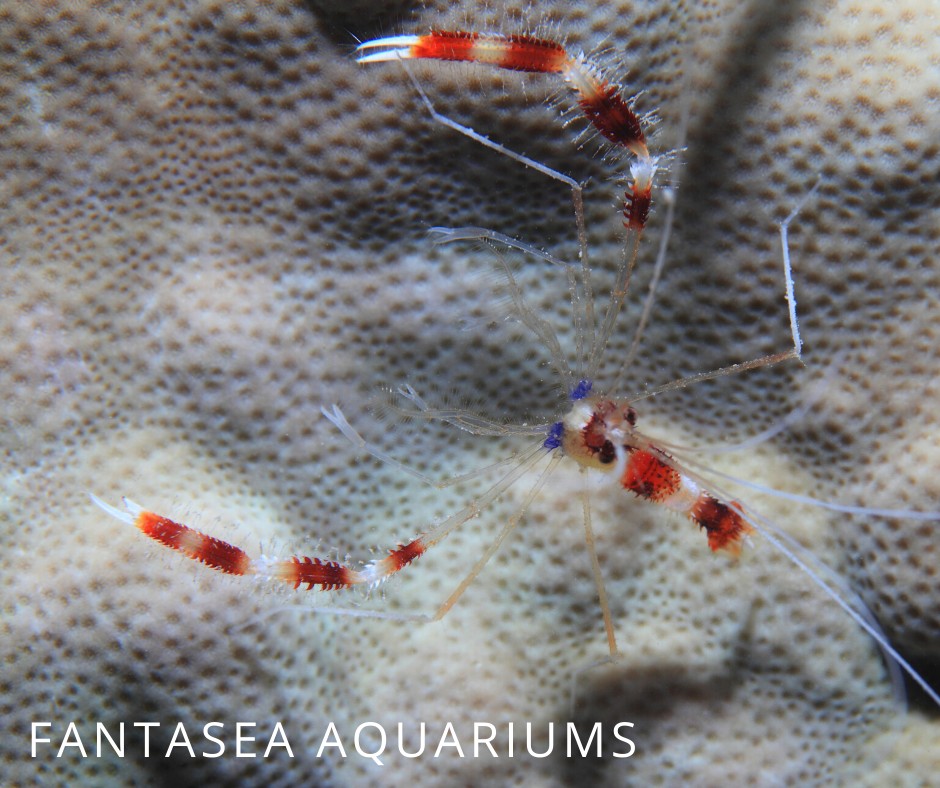If you’re looking for a colorful addition to your saltwater aquarium, the coral banded shrimp might be a good choice for you. Scientifically known as Stenopus hispidus, this one gets its common name from its red-and-white striped body and claws. A colorful and fascinating addition to the aquarium!
Keep reading for everything you need to know about keeping coral banded shrimp in your own tank.
| Name (Common, Scientific) | Coral banded shrimp, banded coral shrimp, banded prawn, boxer shrimp, banded cleaner shrimp, Stenopus hispidus |
| Minimum tank size | 30 gallons |
| Minimum group size | 1 |
| Temperature | 72-78 °F |
| Salinity | 1.022-1.025 |
| pH | 8.1-8.4 |
| Difficulty level | Easy |
Coral banded shrimp natural habitat & description
Description
Although it looks just like one and bears the name, the coral banded shrimp is not actually a true shrimp. Still, it’s closely related to them!
This species was obviously named for its banded coloration, which is red and white with hints of purple. It grows to a maximum size of around 2.5”, with the male being the smaller of the pair.
Coral banded shrimp carry an impressive pair of pincers, which they’ll raise in defense if any fish or invert gets too close for comfort. That’s why they’re also referred to as boxer shrimp.
Natural habitat
The corla banded shrimp is found in tropical and even some subtropical zones throughout the world (referred to as a pan-tropical distribution). From as far north as Canada in the Atlantic and as far south as New Zealand in the Pacific Ocean, it can be found on reefs.
We spotted this species in the wild in the tropical waters around the Dutch Caribbean island of Curaçao; see the cover photo at the top of this article. It’s easy to find using a torch if you keep in mind that it likes to stay on the underside of rock and coral formations.

Coral banded shrimp aquarium
Coral banded shrimp care is pretty straightforward and it’s not too challenging to keep these inverts alive. They do best in aquariums of at least 30 gallons since they need some space to establish their territory.
Since coral banded shrimp are mostly active at night and prefer staying in hiding for much of the day, the aquarium should contain plenty of ledges and crevices.
Be sure to perform regular maintenance on your tank and keep the water values stable. Invertebrates like shrimp don’t respond well to fluctuating water quality at all, so stability is essential to keeping them healthy. That’s why you should also acclimate them carefully when first introducing them to the aquarium!
Coral banded shrimp compatibility
It’s important to keep in mind that coral banded shrimp are territorial. Interestingly, they mate for life, and a pair will defend their designated area together. As such, you might want to avoid keeping more than one pair unless your aquarium is spacious enough to avoid the couples from brawling! Legs and pincers can easily be lost in a territorial battle.
Luckily, the coral banded shrimp’s aggression is limited to things that look like other coral banded shrimp (which includes pretty much any shrimp species, so avoid mixing them). They usually won’t bother fish and therefore make a good addition to a peaceful aquarium. Do keep in mind that, as with all inverts, you should avoid large species that might have an appetite for seafood!
Although coral banded shrimp might annoy your corals by stealing their food and walking all over them, they won’t actively consume them and are therefore considered reef safe.

Coral banded shrimp diet
It’s important to keep your coral banded shrimp well-fed to prevent it from bothering its tankmates. Luckily, like other shrimp, this species will eat pretty much anything it can get its pincers on.
In the wild this is a cleaner shrimp that entices fish to stop by its cave so it can remove their parasites, dead skin and the like. It’s also a general scavenger that feeds on algae, detritus and dead fish.
Coral banded shrimp will feed on leftover foods but it’s a good idea to supplement their diet with frozen foods and invertebrate tabs. You might have to use a shrimp feeding tube or stick to place the food close to the shrimp’s hide, just to ensure other aquarium inhabitants don’t snag it before it can get to it.
Conclusion
A thriving marine aquarium is a fantastic addition to the home or office but it requires plenty of knowledge to set up and regular maintenance to stay healthy.
Not sure whether you’ve got the time or the know-how but still want a beautiful tank? FantaSEA Aquariums can help. Contact us with your ideas and we can design, set up and maintain your aquarium for you!
Tip: If you’re a fan of invertebrates, be sure to take a look at our 5 favorite aquarium shrimp and 5 favorite aquarium crabs.




